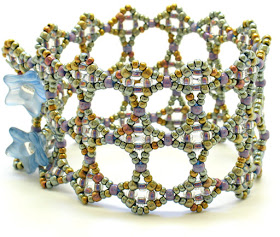Years ago, I'm not sure when, I learned about this configuration of three links is know as the
Borromean rings (or Borromean link), I remember drawing doodles of this three-dimensional shape when I got bored with my professor's lectures.
In 2005, I learned how to weave seed beads with box stitch (e.g., three-dimensional right angle weave), the link was a natural design for me to weave because I had drawn it so many times. I made each rectangle with different colors of seed beads, but the rectangles are all the same size and shape, each measuring 27mm by 18mm by 7mm.
I find the Borromean link is particularly interesting because all three links are collectively linked despite the fact that no two of them are linked to each other. To emphasize this, I left the dark link open so that you can take the three rectangles apart and put them back together again.
This piece was featured in my 2007 paper, "Three-dimensional finite point groups and the symmetry of beaded beads" (
pdf) as and representation of the pyritohedral symmetry group Th. Personally, I remeber this symmetry type as "gift package" as I like to think of it as a the same symmetry as a cube box wrapped with 3 pieces of ribbon. This
Beaded Borromean Link is sold, but if you would like to learn how to make one for yourself, check out the
pattern and kits for the beaded Borromean Links.
Several years ago, I had the honor of hearing
George Hart give a talk on
Orderly Tangles. He presented this talk at in Banff, Canada in 2005 at a math and art conference dedicted to
H.S.M. Coxeter. (Coxeter was a mathematician, particularly interested in geometry, whose work inspired the great mathematical graphic artists
M.C. Escher in the 1950s.) Five years later, I find that Hart's talk was one of the most memorable talks from that conference, at least for me it was.
Hart writes, "In the 1970s and 1980s Alan Holden described symmetric arrangements of linked polygons which he called regular polylinks and constructed many cardboard and stick models. The fundamental geometric idea of symmetrically rotating and translating the faces of a Platonic solid is applicable to both sculpture and puzzles." Listeneing to Hart's talk, I learned about new ways of linking polygons. The result is this set of four linked equilateral triangles. Each triangle is a different shade of green, and they all have matching corners in shiny copper.
The design for the bead woven triangle was origianlly published by Phyllis Dintenfass in
Beadwork magazine, in the Dec 08/Jan 09 issue. It was republished in the special issue called, "Beadwork presents Favorite Bead Stitches" published July 2010.
Once I saw Dintentfass' triangle pattern, I knew immediately that I had to use it to make an orderly tangle. I had been wanting to bead this tangle for a couple of years, and I was thrilled when I found the perfect bead weave to make it. (It's been sitting in my seed bead box for a year and a half, and I finally got around to photographing it.) The edge of each triangle is 42mm and the complete tangle measures 48mm at its longest. This
beaded link is sold.












